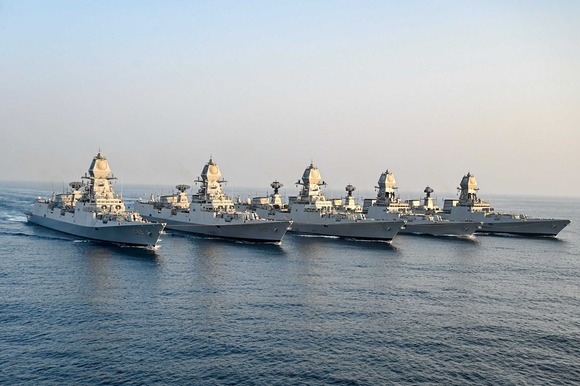
By Government of India
India and the Philippines have carried out their first-ever joint naval exercise and sail in the contested South China Sea, a move that is likely to provoke a strong reaction from China, which claims nearly the entire vital maritime region.
The two-day joint deployment began on Sunday and involved warships from both nations operating within waters claimed by the Philippines. On Monday, Philippine Armed Forces Chief of Staff Romeo Brawner Jr confirmed the sail took place inside the Philippines’ exclusive economic zone (EEZ).
“We did not experience any untoward incidents, but there are still those shadowing us – as we had already expected,” Brawner told journalists, without directly naming China.
In past similar operations conducted with other foreign navies, Chinese naval and coastguard vessels have been observed shadowing from a distance, according to Philippine military officials.
The Indian Navy dispatched three vessels for the exercises: the INS Delhi, a guided missile destroyer; the INS Shakti, a fleet tanker; and the INS Kiltan, an anti-submarine corvette. The Philippine Navy deployed two frigates, the BRP Miguel Malvar and the BRP Jose Rizal.
The joint manoeuvres coincided with Philippine President Ferdinand Marcos Jr’s departure for a five-day state visit to India, during which he stated he would pursue deeper maritime ties and explore bilateral cooperation in defence, agriculture, and pharmaceuticals.
General Brawner expressed optimism about expanding military engagement with India, saying, “We hope that this is just the beginning and that we can participate in more joint exercises with the Indian armed forces in the future.”
He added that the joint deployment “sends a powerful signal of solidarity, strength in partnership and the energy of cooperation between two vibrant democracies in the Indo-Pacific.”
China responded critically. The Ministry of Foreign Affairs issued a statement insisting that territorial and maritime disputes in the region must be resolved solely by the countries directly involved, and warned that no external party should interfere.
Later on Monday, a spokesperson for the People’s Liberation Army’s Southern Theatre Command confirmed China had conducted its own patrols in the disputed waters from August 3 to 4. While described as a “routine” operation, the spokesperson accused the Philippines’ “so-called ‘joint patrol’” of disturbing regional peace and stability.
Just last week, in response to Manila’s stated intent to strengthen military ties with foreign nations, China’s Ministry of National Defense labelled the Philippines a “troublemaker” acting in collusion with outside powers to stir unrest in what Beijing considers its sovereign waters.
“China never wavers in its resolve and will safeguard national territorial sovereignty and maritime rights and interests, and take resolute countermeasures against any provocations by the Philippine side,” spokesperson Zhang Xiaogang told reporters.
The South China Sea remains one of the most strategically vital and hotly contested regions globally, serving as a crucial maritime corridor through which an estimated $3 trillion worth of shipborne trade passes annually.
Although a 2016 ruling by the Permanent Court of Arbitration in The Hague found that China’s expansive territorial claims in the South China Sea have no legal basis under international law, Beijing has refused to recognise or abide by the decision.




